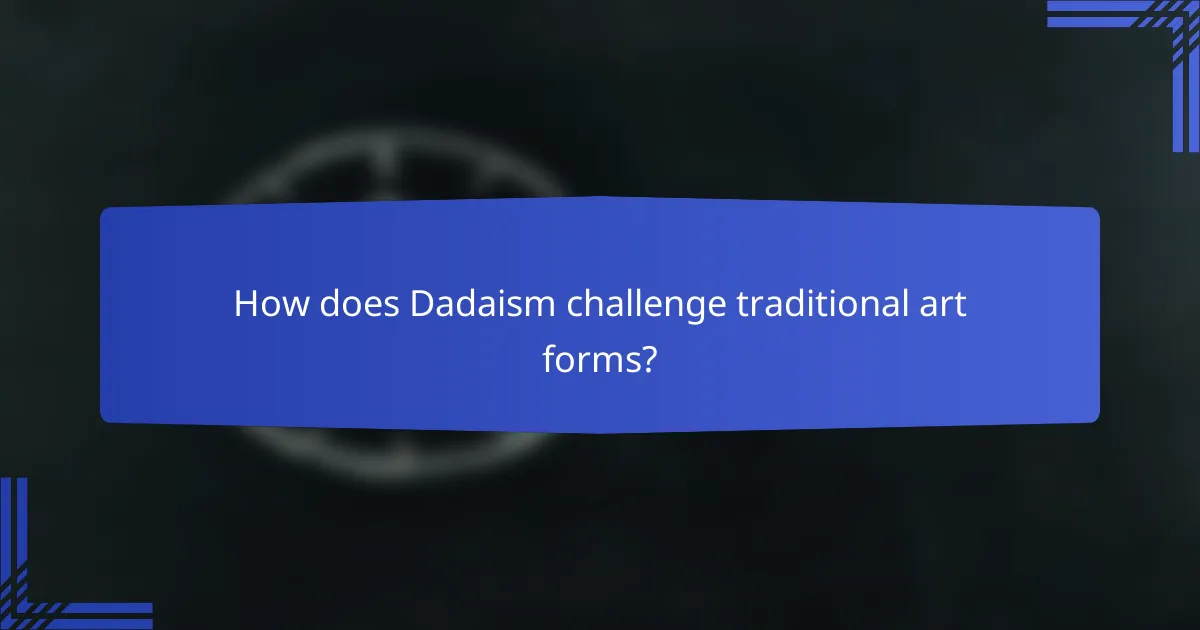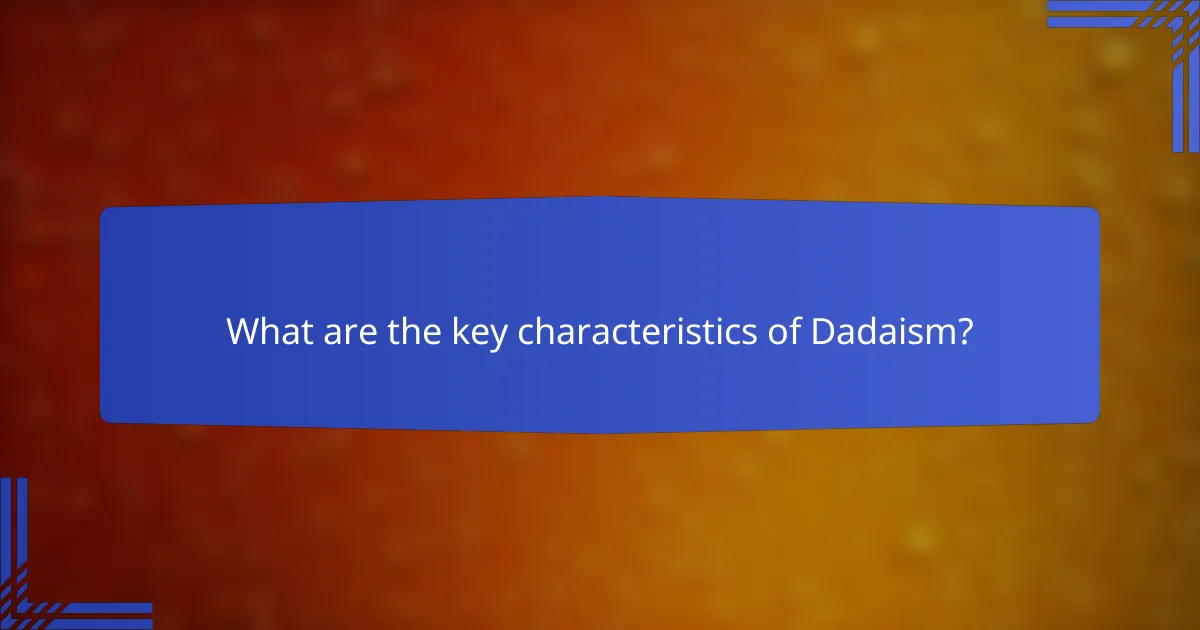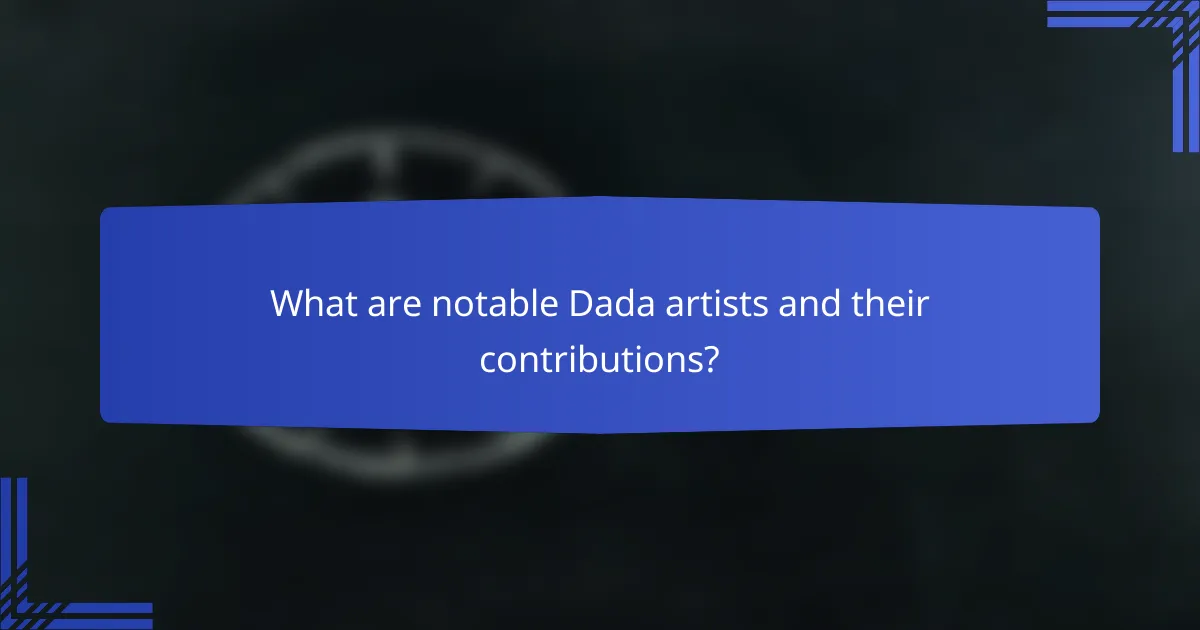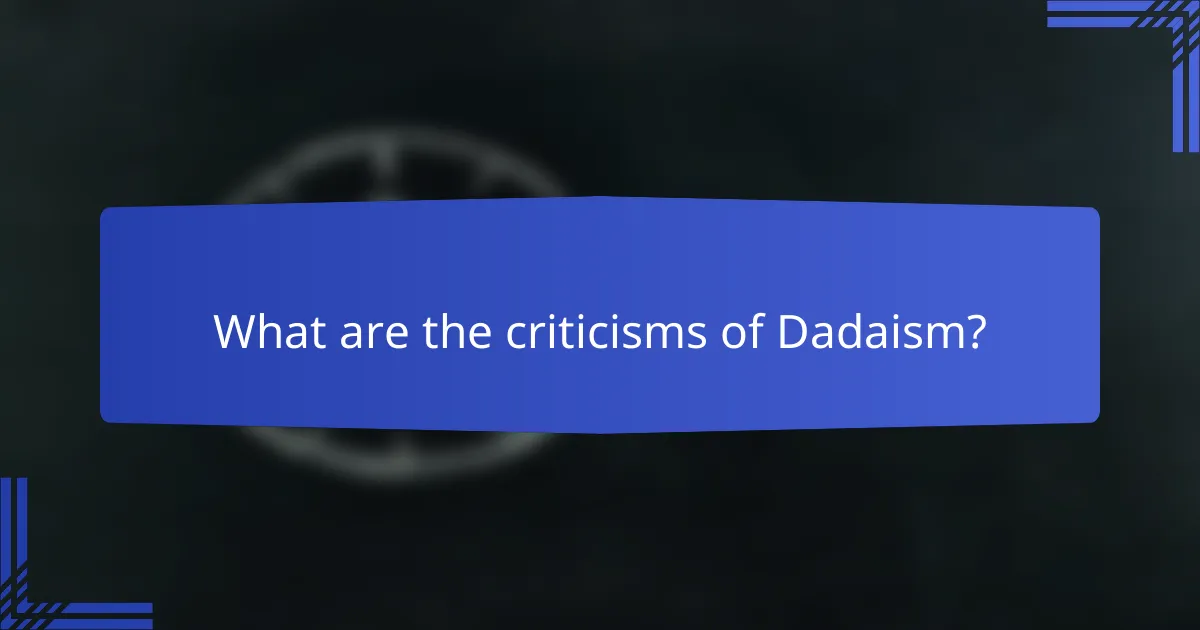Dadaism is an avant-garde movement that emerged in the early 20th century as a reaction to the chaos of World War I, fundamentally challenging traditional artistic values. Emphasizing absurdity, randomness, and anti-art sentiment, Dada artists like Marcel Duchamp and Hannah Höch sought to redefine creativity by embracing spontaneity and nonsensical forms of expression. Through innovative techniques such as collage and assemblage, Dadaism invites viewers to reconsider the very nature of art and its purpose.

How does Dadaism challenge traditional art forms?
Dadaism challenges traditional art forms by rejecting established aesthetic values and embracing chaos and spontaneity. This movement promotes the idea that art can be nonsensical and devoid of purpose, fundamentally altering perceptions of creativity and artistic expression.
Rejection of aesthetic standards
Dadaism fundamentally rejects conventional aesthetic standards that dictate what is considered beautiful or valuable in art. Instead of adhering to traditional techniques and styles, Dada artists often employed unconventional materials and methods, such as collage, assemblage, and performance art, to create works that defy categorization.
This rejection encourages viewers to question their preconceived notions of art and to consider the broader implications of what constitutes artistic merit. For example, a Dadaist piece might include everyday objects arranged in a way that challenges the viewer’s expectations, prompting a reevaluation of artistic value.
Emphasis on randomness
Randomness plays a crucial role in Dadaism, as artists often embraced chance as a creative force. Techniques such as automatic drawing, where artists allow their hands to move freely without conscious control, exemplify this approach. This method highlights the unpredictability of the creative process and the idea that art can emerge from chaos.
By incorporating random elements, Dadaists encourage spontaneity and surprise, fostering an environment where the unexpected becomes a source of inspiration. This can be seen in works that combine disparate elements, creating a sense of disarray that challenges viewers to find meaning in the randomness.
Use of absurdity
Absurdity is a hallmark of Dadaism, as artists often create works that are intentionally nonsensical or illogical. This approach serves to critique societal norms and conventions, revealing the absurdity of the modern world. Dadaist performances and artworks frequently include bizarre juxtapositions and surreal imagery that provoke thought and laughter.
For instance, a Dadaist play might feature nonsensical dialogue and unexpected plot twists, reflecting the chaos of contemporary life. By embracing absurdity, Dadaism invites audiences to confront the irrational aspects of existence and to find humor in the chaos surrounding them.

What are the key characteristics of Dadaism?
Dadaism is characterized by its anti-art sentiment, emphasis on spontaneity, and innovative use of collage and assemblage techniques. This movement emerged as a reaction to the chaos of World War I, challenging traditional artistic values and embracing absurdity and randomness.
Anti-art sentiment
The anti-art sentiment in Dadaism rejects conventional aesthetics and the notion that art must have a specific purpose or meaning. Dada artists often created works that were intentionally nonsensical or provocative, aiming to shock the audience and question societal norms.
For instance, Marcel Duchamp’s “Fountain,” a urinal presented as art, exemplifies this rejection of traditional artistic values. By presenting everyday objects as art, Dadaists challenged the very definition of what art could be.
Emphasis on spontaneity
Dadaism places a strong emphasis on spontaneity, encouraging artists to create without premeditation or constraints. This approach often led to unexpected and chaotic results, reflecting the randomness of life itself.
Artists like Jean Arp would create works by allowing chance to dictate their artistic process, such as dropping pieces of paper and arranging them as they fell. This method highlights the Dada belief that art should be free from rational thought and deliberate intention.
Collage and assemblage techniques
Collage and assemblage are key techniques in Dadaism, involving the combination of various materials and objects to create new artworks. These methods allow artists to break down the boundaries between different art forms and challenge traditional artistic practices.
For example, Hannah Höch’s photomontages combined photographs, text, and other materials to critique contemporary society and politics. This technique not only showcased the absurdity of modern life but also emphasized the Dadaist belief in the power of randomness and juxtaposition in art.

What are notable Dada artists and their contributions?
Notable Dada artists include Marcel Duchamp, Hannah Höch, and Tristan Tzara, each contributing significantly to the movement’s anti-art sentiment through innovative works and ideas. Their creations challenged traditional notions of art, embracing absurdity and randomness to provoke thought and discussion.
Marcel Duchamp’s “Fountain”
Marcel Duchamp’s “Fountain,” a urinal presented as art in 1917, is one of the most famous Dada works. By submitting this everyday object to an art exhibition, Duchamp questioned the very definition of art and the role of the artist.
This piece exemplifies Dada’s embrace of absurdity and randomness, as it turned a mundane item into a provocative statement. Duchamp’s work encouraged viewers to reconsider their perceptions of artistic value and originality.
Hannah Höch’s photomontages
Hannah Höch was a pioneer of photomontage, using cut-out photographs to create collages that critiqued societal norms and gender roles. Her works often juxtaposed images from popular culture with political commentary, reflecting the chaotic nature of the Dada movement.
One of her notable pieces, “Cut with the Kitchen Knife Dada through the Last Weimar Beer-Belly Cultural Epoch in Germany,” showcases her skill in blending absurdity with sharp social critique. Höch’s art remains influential in discussions about feminism and media representation.
Tristan Tzara’s manifestos
Tristan Tzara, a key figure in Dada, authored several manifestos that outlined the movement’s philosophy and goals. His writings emphasized spontaneity, randomness, and the rejection of conventional aesthetics, urging artists to embrace chaos and absurdity.
Tzara’s manifestos served as rallying cries for Dadaists, promoting the idea that art should not conform to established norms. His influence extended beyond literature into visual arts, inspiring future generations to challenge artistic boundaries.

How did Dadaism influence modern art movements?
Dadaism significantly shaped modern art movements by introducing concepts of absurdity, randomness, and anti-art sentiment. Its rejection of traditional aesthetics paved the way for various avant-garde movements, encouraging artists to explore new forms of expression and challenge societal norms.
Impact on Surrealism
Dadaism’s emphasis on irrationality and the subconscious directly influenced Surrealism, which sought to unlock the creative potential of the unconscious mind. Surrealists adopted Dada’s techniques, such as automatic writing and collage, to create dream-like imagery that defied logic.
For example, artists like Max Ernst and Salvador Dalí incorporated Dadaist principles, using unexpected juxtapositions and bizarre scenarios to provoke thought and evoke emotion. This blending of Dada’s absurdity with surrealist exploration resulted in a powerful movement that questioned reality itself.
Connection to Conceptual Art
Dadaism laid the groundwork for Conceptual Art by prioritizing ideas over traditional artistic techniques. This shift encouraged artists to focus on the concept behind their work rather than the aesthetic qualities, leading to a broader interpretation of what art could be.
Artists such as Marcel Duchamp, a key figure in Dadaism, challenged the notion of art by presenting everyday objects as art pieces, a practice that Conceptual artists later embraced. This connection emphasizes the importance of context and meaning, which remains central to contemporary art discussions today.

What is the historical context of Dadaism in the UK?
Dadaism emerged as a radical art movement in the early 20th century, primarily as a reaction to the chaos of World War I. In the UK, it challenged traditional artistic norms and embraced absurdity and randomness, reflecting the disillusionment of the time.
Emergence during World War I
The Dada movement began in Europe around 1916, coinciding with the horrors of World War I. Artists and intellectuals in the UK, disillusioned by the war’s brutality, sought to reject conventional aesthetics and societal values.
This anti-art sentiment manifested in various forms, including poetry, visual arts, and performance. Dadaists aimed to provoke thought and challenge the status quo, often using nonsensical elements to highlight the absurdity of war and life.
Influence of the Cabaret Voltaire
The Cabaret Voltaire, founded in Zurich in 1916, played a crucial role in the development of Dadaism, influencing artists across Europe, including those in the UK. This venue became a hub for avant-garde performances, where poetry, music, and visual art collided in unpredictable ways.
UK Dadaists drew inspiration from the Cabaret Voltaire’s emphasis on spontaneity and the absurd. They adopted similar techniques, such as collage and chance operations, to create works that challenged viewers’ perceptions and expectations.

How is Dadaism perceived in contemporary culture?
Dadaism is often viewed as a foundational movement that challenges traditional notions of art, emphasizing absurdity and randomness. In contemporary culture, it continues to inspire artists and thinkers who explore themes of chaos and anti-art sentiment.
Relevance in postmodern art
Dadaism’s influence is evident in postmodern art, where the boundaries of what constitutes art are continually tested. Artists often incorporate elements of absurdity and randomness, reflecting Dada’s rejection of conventional aesthetics.
For example, contemporary installations may include everyday objects arranged in unexpected ways, prompting viewers to question their perceptions of art. This approach encourages a dialogue about meaning and value in artistic expression.
Influence on performance art
Dadaism has significantly shaped performance art by promoting spontaneity and audience interaction. Many performance artists draw from Dada’s principles, creating works that challenge societal norms and provoke thought through absurdity.
Performances may involve unpredictable elements, such as improvisation or audience participation, mirroring Dada’s emphasis on randomness. This unpredictability keeps the audience engaged and often leads to a deeper exploration of the themes presented.

What are the criticisms of Dadaism?
The criticisms of Dadaism often center around its perceived lack of coherence and meaning, as well as its rejection of traditional artistic values. Critics argue that its emphasis on absurdity and randomness can lead to a disconnect between the artist and the audience, making it difficult for viewers to engage with the work.
Rejection of Traditional Art Forms
Dadaism fundamentally challenges established artistic norms, which can alienate those who value conventional aesthetics. By dismissing traditional techniques and embracing chaos, Dada artists often leave critics feeling that the movement lacks seriousness or depth. This rejection can be seen as a direct affront to the art community, leading to polarized opinions.
Absurdity and Randomness
The embrace of absurdity and randomness in Dada works can be unsettling for audiences accustomed to narrative and structure. Critics argue that this lack of coherence may render the art inaccessible, as it often requires viewers to engage with the work on a purely emotional or instinctual level. This can create confusion, as the intent behind the art is not always clear.
Commercialization of Art
Some critics contend that Dadaism’s anti-art stance paradoxically contributes to the commercialization of art. By promoting the idea that anything can be considered art, Dadaism can blur the lines between genuine artistic expression and marketable products. This raises questions about the value of art and the motivations behind its creation.
Impact on Future Movements
Dadaism’s influence on subsequent art movements, such as Surrealism and Pop Art, is often viewed with skepticism. Critics argue that while it opened doors for experimentation, it also led to a dilution of artistic integrity. The challenge remains for contemporary artists to balance innovation with meaningful expression, avoiding the pitfalls that Dadaism sometimes exemplified.
